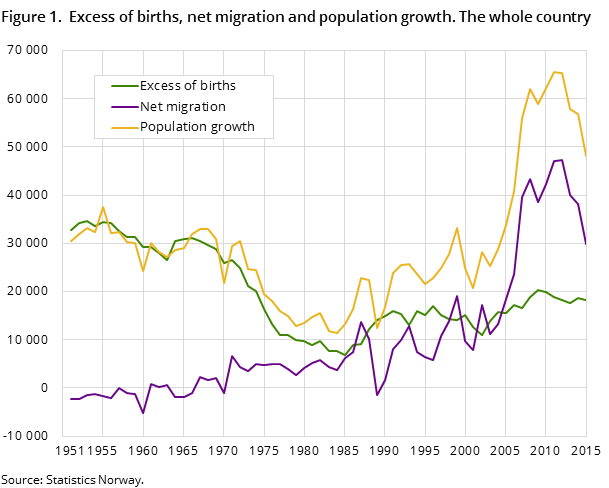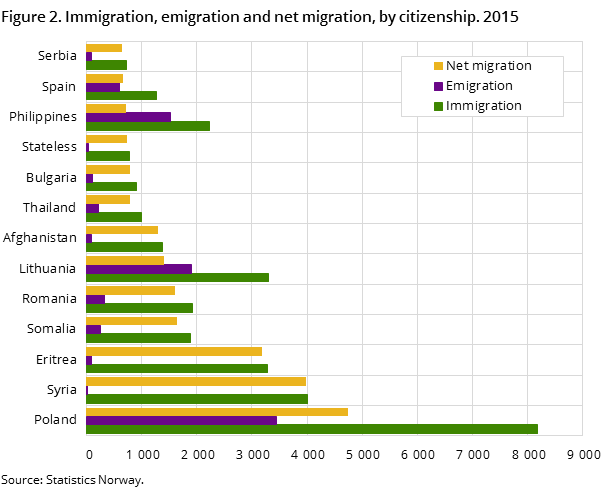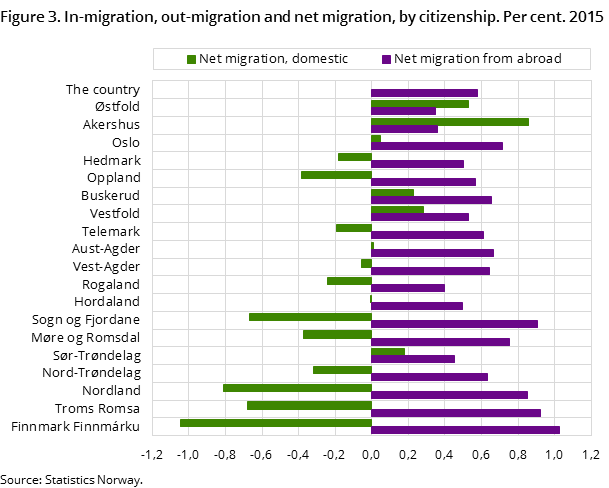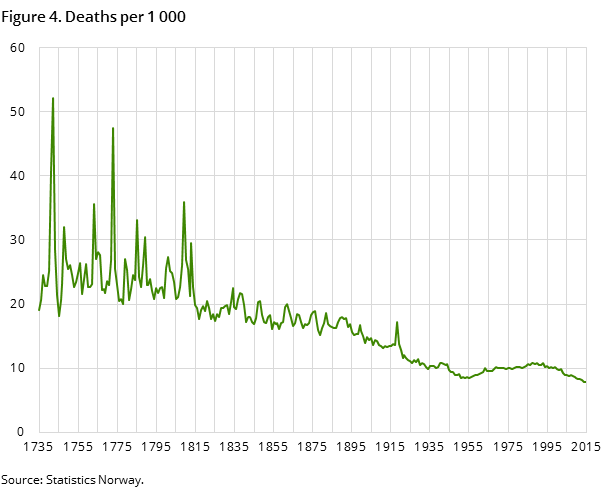Content
Published:
This is an archived release.
Internal migration surplus in Akershus, loss in Rogaland
At the turn of the year, the population totalled 5 214 000, which is a growth of 48 200 in 2015. This growth was lower than in previous years, particularly because of higher emigration. Rogaland had a significantly larger internal migratory loss than in 2014, while Akershus experienced a far larger surplus than in 2014.
| 4th quarter 2015 | 4th quarter 2014 | Changes from same period previous year | |
|---|---|---|---|
| Population at the beginning of the quarter | 5 205 434 | 5 156 451 | 48 983 |
| Births | 13 218 | 13 358 | -140 |
| Deaths | 10 221 | 10 521 | -300 |
| Excess of births | 2 997 | 2 837 | 160 |
| Immigration | 15 829 | 16 073 | -244 |
| Emigration | 10 397 | 9 484 | 913 |
| Net migration, immigration and emigration incl | 5 432 | 6 589 | -1 157 |
| Population growth | 8 551 | 9 351 | -800 |
| Population at the end of the quarter | 5 213 985 | 5 165 802 | 48 183 |




The population increased in all counties in 2015, but the increase was lower than in 2014 in 12 of the counties. Oslo and Akershus saw the highest growth; 20 300 combined, and while Akershus had a larger increase than in 2014, Oslo experienced a lower increase in 2015. The combined population growth in Rogaland and Hordaland was 9 000, and the increase in Rogaland in particular was significantly lower than in the previous year.
Large internal net migration to Akershus
All counties with the exception of Finnmark had a total net migration surplus, with the highest in Akershus. In order to show the disparities between counties, migration can be broken down into two categories - moving from and to abroad, and internal migration.
Seven counties had an internal migration surplus, i.e. more people moved in from other areas of the country than moved out to other areas of the country. However, only one county stood out; Akershus with a surplus of 5 000 persons, which is 2 000 more than in 2014 and 58 per cent of the total surplus for the counties that had a surplus. Twelve counties had an internal migration loss, i.e. more people moved out to other areas of the country than moved in from other areas of the country. The largest change from 2014 to 2015 was seen in Rogaland, where a loss of 250 in 2014 increased to a loss of 1 100 in 2015. This is probably due to the changes recently observed in the labour market.
Net in-migration from abroad – in-migration from abroad minus out-migration to abroad – was clearly highest in Oslo in 2015, with 4 600. As a percentage of the population, the figure was highest in two of the three northernmost counties; Finnmark and Troms. Net in-migration from abroad outweighed the internal net migration loss and birth deficit. The population increased in all but one of the counties, but without the in-migration surplus 9 of the 19 counties would have seen a decrease.
Largest ever out-migration and lower in-migration leads to lower population growth
The population increased by 48 200 persons last year, which was 8 600 fewer than in 2014 and the lowest increase since 2006. Higher out-migration and lower in-migration were the main reasons for this. Net in-migration from abroad decreased from 38 150 in 2014 to 29 800 last year, and is the lowest since 2006. Nevertheless, net in-migration remains high, and far higher than during the years prior to 2006. A total of 67 300 in-migrations were registered, which was 2 750 fewer than the year before. A total of 37 500 persons left the country, which was 5 600 more than in 2014, and the highest number ever registered.
Syrian citizens constitute second largest group of immigrants
Net in-migration of foreign citizens has decreased from 48 700 in 2012 to 38 100 in 2014 and 31 700 in 2015. Of this, 14 700 were net in-migrations by European citizens, which is 9 000 fewer than in the previous year. Net in-migration by non-European citizens on the other hand increased, from 14 500 in 2014 to 17 000 in 2015. This group constituted more than half of the net in-migration in 2015, compared to just 38 per cent in 2014. European citizens therefore constituted a smaller part of the total net in-migration in 2015 than the previous year, down from 62 to 46 per cent.
Citizens from seven countries had a net in-migration of more than 1 000, and three of these countries are European. Polish citizens still constitute the largest group, but the net in-migration of 4 700 is far lower than the peak in 2007 of 12 900. The net in-migration of 1 400 Lithuanian citizens was also far lower than the 2011 figure of 7 300. The net migration of Swedish citizens has changed in recent years, from a net in-migration of 3 300 in 2010 to a net out-migration of 20 in 2015.
Persons with a refugee background from Syria, Eritrea, Somalia and Afghanistan accounted for four of the seven large groups. Syrian citizens in 2015 constituted the second largest group, with a net in-migration of 4 000; twice as many as the previous year. Net in-migration from Somalia, Eritrea and Afghanistan combined increased from 4 900 in 2014 to 6 100 in 2015.
Although large numbers from some European countries immigrate to Norway, just as many emigrate, resulting in a very low or even negative net in-migration. This applies to the previously mentioned Swedes, as well as citizens of Denmark, France and Germany.
Birth surplus at same level
A total of 59 000 children were born in 2015, and 40 700 persons died, resulting in a birth surplus of 18 300. This is slightly lower than the previous year, but the highest since the mid-1970s, apart from the period 2008-2011.
The total fertility rate for 2015 was 1.73 compared to 1.95 in 2010. The 2015 level was the lowest since 1986.
Life expectancy increased for both men and women, with men seeing the greatest increase. A boy born in 2015 is expected to live for 80.4 years, while a girl can expect to live for 84.2 years. This is an increase of five months for boys and one month for girls compared to the previous year.
Contact
-
Magnus Haug
E-mail: magnus.haug@ssb.no
tel.: (+47) 40 81 14 91
-
Karstein Sørlien
E-mail: karstein.sorlien@ssb.no
tel.: (+47) 47 70 16 35
-
Linn Krokedal
E-mail: linn.krokedal@ssb.no
tel.: (+47) 95 47 97 47
-
Anders Sønstebø
E-mail: anders.sonstebo@ssb.no
tel.: (+47) 46 66 37 74
-
Espen Andersen
E-mail: espen.andersen@ssb.no
tel.: (+47) 92 61 00 46
-
Statistics Norway's Information Centre
E-mail: informasjon@ssb.no
tel.: (+47) 21 09 46 42
-
Oppdrag befolkningsstatistikk
E-mail: befolkning@ssb.no
